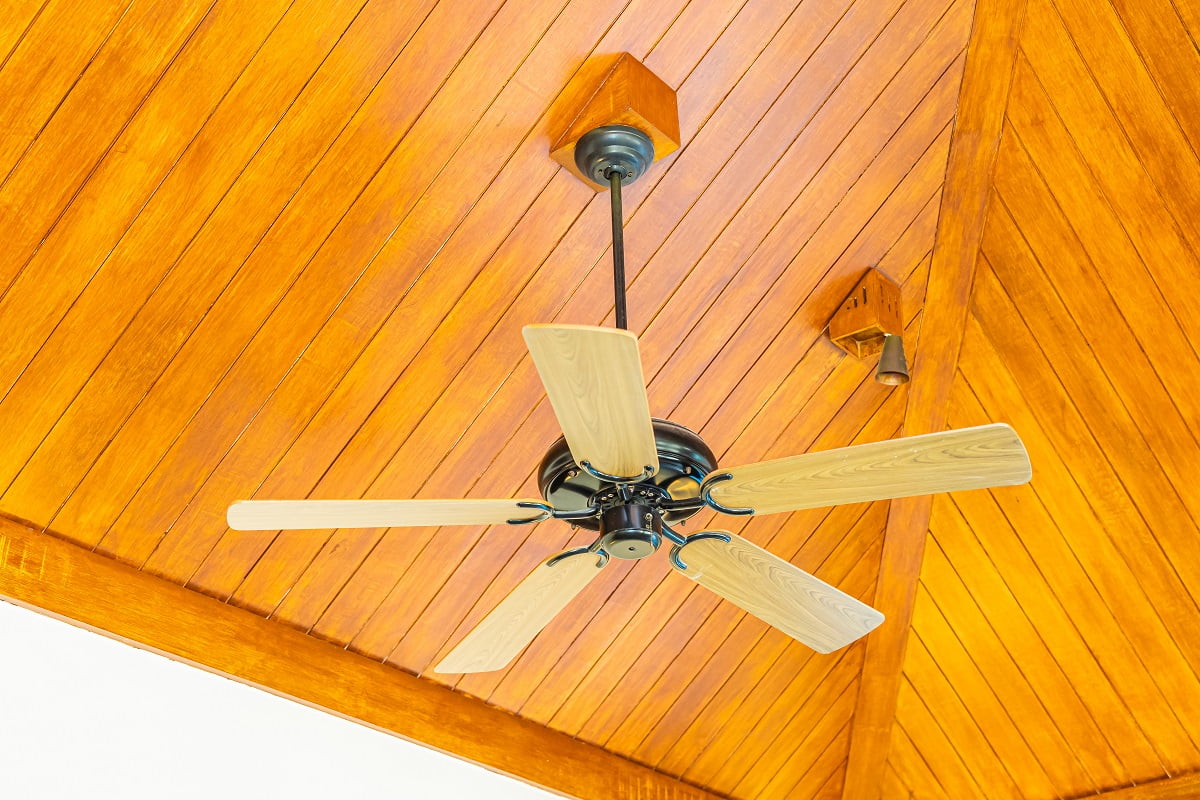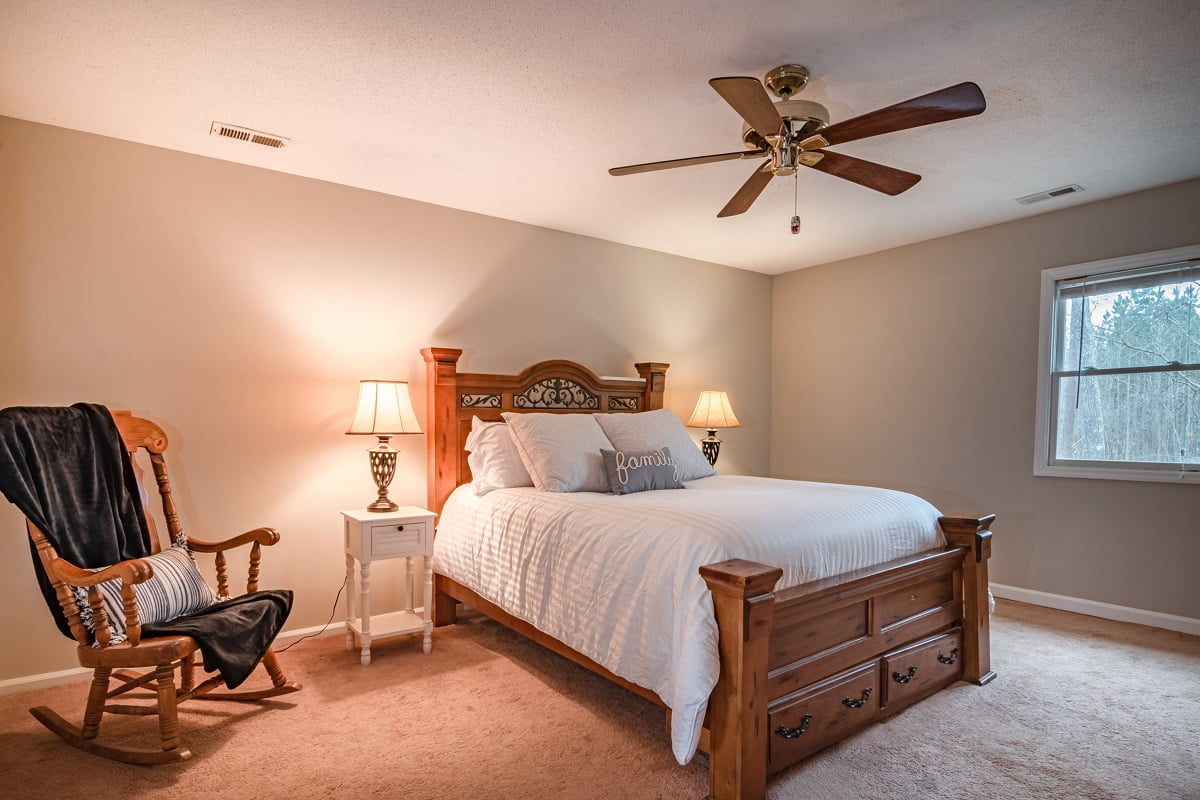Just like a lower fan, it’s quite common for a ceiling fan to malfunction due to incorrect rotation, damaged blades or bases. And a malfunctioning ceiling fan needs to be fixed at the earliest unless you want it to stop functioning altogether.

Although ceiling fans can be complete lifesavers during the humid summer months, they aren’t immune to malfunctioning. In many cases, they can become dysfunctional and reduced to just an accessory in your room.
As mentioned above, ceiling fans can malfunction or produce less air for a number of reasons. And today, we are going to decode some of the most common causes behind this trouble. And compare it with blowing fans which are different in many things, such as size, function and others.
So, let’s dive in!
Reasons For Ceiling Fan Not Blowing Air

1. Incorrect Ceiling Fan Size
If the fan is smaller compared to the size of your room, chances are that you won’t feel its cool breeze at all. Small fan blades are only suitable for tiny spaces and not when the room’s square footage is more.
Be it a ceiling fan or a pedestal, when the fan blades are too small they cannot move enough air on the surface area. So, the ceiling fan blades will be turning all day without providing the required air.
Another problem that is commonly noticed with these fans is small fan motors, which do not have enough power to generate high speed or move the heavy blades. In that case, you will be stuck with a slow fan that doesn’t serve the purpose.
2. Improper Fan Blade Rotation
The direction in which your fan’s blades spin determines how far the air will reach. Contrary to the much-popular myth, you won’t experience proper airflow in the clockwise setting. On the other hand, the blade pulls air upward and pushes air down the walls when spinning in the opposite (anticlockwise) direction.
If you do set the fan to spin anticlockwise, the blades will push air downward, and you will experience better airflow in the room. The only problem here is that the airflow can be best experienced right under the fan, as the blades won’t blow air much to the sides.
Most ceiling fans that you find on the market come with a switch that allows you to change the fan’s direction. An incorrect fan blade rotation can completely ruin your experience, so we’d suggest checking and changing the settings when you get a new ceiling fan.
3. Dysfunctional Motor Base
You might have to do a ceiling fan troubleshooting when it has been used for a long time and if the motor’s base does not rotate properly. If the ceiling fan wobbles, it’s likely due to the motor shaft or base becoming tilted. And when tilted, the weight completely shifts to one side, resulting in reduced fan speed.
With dysfunctional motor bases, fans won’t pull air upward or circulate it well. In that case, you will need to fix the issue soon.
If you are not sure if the motor base is tilted or not, keep an eye out for these indications:
- The blades incline to one side, especially in older fans
- The ceiling screws or the blade screws are no longer tight
- Loose wires are visible above the motor base of the fan and touching the ceiling.
- Loud clicking or ticking noise when the fan is switched on.
4. Issues With Fan Height
You would be surprised to know that the height of your fan might actually affect how well it can circulate air. If the fan is installed too high, you won’t feel enough airflow. So, if you have a high ceiling, try installing the fan lower to increase the airflow.
On the other hand, if the fan is installed too low, it won’t be able to circulate more air and will concentrate the flow only to a smaller area. While this might not be a problem in a small room, the fan would become pretty useless in a large room.
5. Issues With The Blade Shape And Style
Not all fans are made equal. While some are designed for high performance, there are others that will function more as art pieces to enhance the beauty and decor of the room.
The good news is that the blade size won’t make much of a difference if your room is big, well-ventilated and already has good airflow. However, if the room is small and doesn’t have proper airflow, you should find a fan with a powerful motor. That way, it will move air well, irrespective of the blade size.
Ceiling Fan Not Blowing Air Frequently Asked Questions ?
Does a ceiling fan capacitor affect the fan speed?
Whether it’s a new fan or an old one, you should always check if the capacitor is functioning properly to ensure high speed. When there are faulty capacitors, you will notice that the mounted fans turn slow, or in the worst-case scenario, they stop functioning altogether.
There are many people who wonder, “what fan blows the coldest air?” But let us tell you, more than the fan, it is the attachments that should be functional and in the best shape. Only when the fan capacitor, circuit breaker, and motor shaft are all in place and running well can you experience the best air movement.
How to fix misaligned fan blades?
You might notice misaligned blades on your fan for a variety of reasons. Whatever the cause, misaligned blades cause an imbalance in the overall weight of the fan to affect its efficacy.
To fix this issue, start by loosening the screws on the blade arms. Once they are loosened, realign the blades to ensure they are straight and aligned. Then tighten the screws properly.
After you are done, switch on the fan and check if all the blades are aligned correctly. In case you notice that the blades keep getting loose, use larger screws to ensure they stay tightened and in place.
How to make the most of ceiling fans in summers?
Always make sure that your ceiling fan is spinning anticlockwise during the hit summer days. This will create a downdraft, and you will experience a cool breeze when you sit right under the fan. Besides, the fan should be set at the highest speed.
You can even put a blower fan in the room to facilitate improved ventilation. Read our guide on “how does a blower fan work?” to learn all about it.
How to stop the screeching noise in ceiling fans?
You will need to get the base of the fan fixed if you notice that it is rusted or corroded; otherwise, it will keep grinding and generate an annoying screeching sound. The sound is an indication that the bearings need to be replaced, so changing them should resolve the problem.

Ceiling Fan Not Blowing Air Final Words
In most cases, it isn’t a major malfunction that stops a fan from functioning efficiently. Rather, it is the small mistakes on our part that prevents it from functioning optimally. For instance, a fan rotating in the “reverse” direction can cause it to pull the air upwards instead of pushing it down.
Such issues can be fixed the DIY way with a few simple alterations, some problems may result from a more serious technical fault. So, if your DIY fix is not yielding satisfactory results, it may be a good idea to call a professional to detect the problem and resolve it at the earliest.
See you next time!
